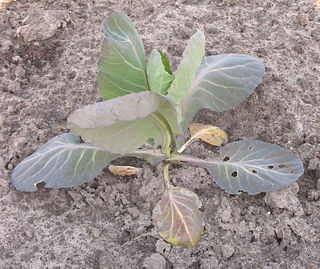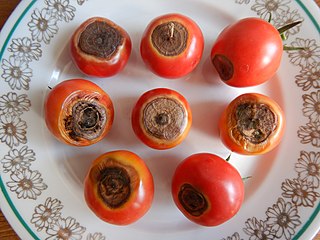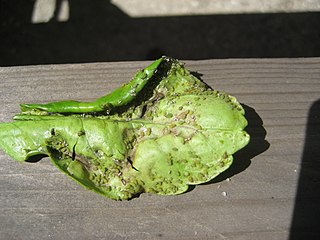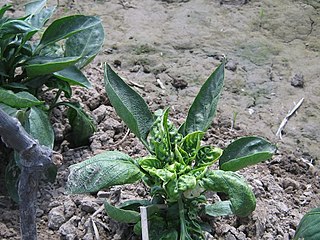Related Research Articles

Nitrogen deficiency is a deficiency of nitrogen in plants. This can occur when organic matter with high carbon content, such as sawdust, is added to soil. Soil organisms use any nitrogen available to break down carbon sources, making nitrogen unavailable to plants. This is known as "robbing" the soil of nitrogen. All vegetables apart from nitrogen fixing legumes are prone to this disorder.

Citrus production encompasses the production of citrus fruit, which are the highest-value fruit crop in terms of international trade. There are two main markets for citrus fruit:

Physalis peruviana, is a South American plant native to Colombia, Ecuador and Peru in the nightshade family (Solanaceae), commonly known as Cape gooseberry or goldenberry, known in its countries of origin as aguaymanto, uvilla or uchuva, in Hawaii called poha, and in Egypt called Harankash, in addition to numerous indigenous and regional names. The goldenberry is also known as ground cherry. The history of P. peruviana cultivation in South America can be traced to the Inca Empire. It has been cultivated in England since the late 18th century, and in South Africa in the Cape of Good Hope since at least the start of the 19th century. Widely introduced in the 20th century, P. peruviana is cultivated or grows wild across the world in temperate and tropical regions.

Citrus greening disease is a disease of citrus caused by a vector-transmitted pathogen. The causative agents are motile bacteria, Liberibacter spp. The disease is vectored and transmitted by the Asian citrus psyllid, Diaphorina citri, and the African citrus psyllid, Trioza erytreae, also known as the two-spotted citrus psyllid. It has also been shown to be graft-transmissible. Three different types of HLB are currently known: the heat-tolerant Asian form, and the heat-sensitive African and American forms. The disease was first described in 1929 and first reported in China in 1943. The African variation was first reported in 1947 in South Africa, where it is still widespread. Eventually, it affected the United States, reaching Florida in 2005. Within three years, it had spread to the majority of citrus farms. The rapid increase in this disease has threatened the citrus industry not only in Florida, but the entire US. As of 2009, 33 countries have reported HLB infection in their citrus crop.

A leaf spot is a limited, discoloured, diseased area of a leaf that is caused by fungal, bacterial or viral plant diseases, or by injuries from nematodes, insects, environmental factors, toxicity or herbicides. These discoloured spots or lesions often have a centre of necrosis. Symptoms can overlap across causal agents, however differing signs and symptoms of certain pathogens can lead to the diagnosis of the type of leaf spot disease. Prolonged wet and humid conditions promote leaf spot disease and most pathogens are spread by wind, splashing rain or irrigation that carry the disease to other leaves.
The potato spindle tuber viroid (PSTVd) was the first viroid to be identified. PSTVd is a small, single stranded circular RNA molecule closely related to the chrysanthemum stunt viroid. Present within the viroidal RNA is the Pospiviroid RY motif stem loop common to its genus. The natural hosts are potatoes and tomatoes. All potatoes and tomatoes are susceptible to PSTVd and there is no form of natural resistance. Natural infections have also been seen in avocados and infections in other solanaceous crops have been induced in the laboratory. Until 2017 PSTVd was thought to be unable to infect Solanum sisymbriifolium. Then in May seeds exported by a Dutch company were noticed to be infected. These seeds were shipped from the company, but had been originally bred to their specifications in two Asian countries. Pstv also causes Tomato bunchy top and is seed transmitted in tomato.

Potato leafroll virus (PLRV) is a member of the genus Polerovirus and family Solemoviridae. The phloem limited positive sense RNA virus infects potatoes and other members of the family Solanaceae. PLRV was first described by Quanjer et al. in 1916. PLRV is transmitted by aphids, primarily the green peach aphid, Myzus persicae. PLRV is one of the most important potato viruses worldwide but particularly devastating in countries with limited resources and management. It can be responsible for individual plant yield losses of over 50%. One estimate suggests that PLRV is responsible for an annual global yield loss of 20 million tons. Symptoms include chlorosis, necrosis and leaf curling.

Phthorimaea operculella, also known as the potato tuber moth or tobacco splitworm, is a moth of the family Gelechiidae. It is an oligophagous insect that feeds on the plant family Solanaceae and is especially known for being a major pest of potato crops. Currently farmers utilize insecticides, parasites, and sprinkler irrigation in order to prevent P. operculella from infesting their croplands.

Ralstonia solanacearum is an aerobic non-spore-forming, Gram-negative, plant pathogenic bacterium. R. solanacearum is soil-borne and motile with a polar flagellar tuft. It colonises the xylem, causing bacterial wilt in a very wide range of potential host plants. It is known as Granville wilt when it occurs in tobacco. Bacterial wilts of tomato, pepper, eggplant, and Irish potato caused by R. solanacearum were among the first diseases that Erwin Frink Smith proved to be caused by a bacterial pathogen. Because of its devastating lethality, R. solanacearum is now one of the more intensively studied phytopathogenic bacteria, and bacterial wilt of tomato is a model system for investigating mechanisms of pathogenesis. Ralstonia was until recently classified as Pseudomonas, with similarity in most aspects, except that it does not produce fluorescent pigment like Pseudomonas. The genomes from different strains vary from 5.5 Mb up to 6 Mb, roughly being 3.5 Mb of a chromosome and 2 Mb of a megaplasmid. While the strain GMI1000 was one of the first phytopathogenic bacteria to have its genome completed, the strain UY031 was the first R. solanacearum to have its methylome reported. Within the R. solanacearum species complex, the four major monophyletic clusters of strains are termed phylotypes, that are geographically distinct: phylotypes I-IV are found in Asia, the Americas, Africa, and Oceania, respectively.

Stemphylium solani is a plant pathogen fungus in the phylum Ascomycota. It is the causal pathogen for grey leaf spot in tomatoes and leaf blight in alliums and cotton, though a wide range of additional species can serve as hosts. Symptoms include white spots on leaves and stems that progress to sunken red or purple lesions and finally leaf necrosis. S. solani reproduces and spreads through the formation of conidia on conidiophores. The teleomorph name of Stemphyllium is Pleospora though there are no naturally known occurrences of sexual reproduction. Resistant varieties of tomato and cotton are common, though the pathogen remains an important disease in Chinese garlic cultivation.

Alternaria solani is a fungal pathogen that produces a disease in tomato and potato plants called early blight. The pathogen produces distinctive "bullseye" patterned leaf spots and can also cause stem lesions and fruit rot on tomato and tuber blight on potato. Despite the name "early," foliar symptoms usually occur on older leaves. If uncontrolled, early blight can cause significant yield reductions. Primary methods of controlling this disease include preventing long periods of wetness on leaf surfaces and applying fungicides. Early blight can also be caused by Alternaria tomatophila, which is more virulent on stems and leaves of tomato plants than Alternaria solani.

Bactericera cockerelli, also known as the potato psyllid, is a species of psyllid native to southern North America. Its range extends from Central America north to the American Pacific Northwest and parts of Manitoba, in Canada. It is restricted to the western part of the continent. As its name suggests, it is commonly found on potato and tomato crops, but has a species range that encompasses over 40 species of solanaceous plants and as many as 20 genera. Breeding hosts are generally recognised as being restricted primarily to Solanaceae, including important crop and common weed species, and a few species of Convolvulaceae, including bindweed and sweet potato. On some plants, especially potato, feeding of the nymphs causes a condition called psyllid yellows, presumed to be the result of a toxin. Both nymphs and adults can transmit the bacterium Candidatus Liberibacter.

Zebra chip, also known as papa manchada and papa rayada, is a disease in potatoes putatively caused by an alphaproteobacteria "Candidatus Liberibacter solanacearum", which is vectored by the potato psyllid. When fried, potato tubers from infected plants develop unsightly black lines resembling the stripes of zebras that render the chips unsellable. Additionally, striped sections of chips frequently burn and caramelize, resulting in a bitter flavor. No health risks have been connected with consumption of infected potato chips.
Texas Phoenix palm decline, or lethal bronzing, is a plant disease caused by a phytoplasma, Candidatus Phytoplasma palmae. It takes its name from the state it was first identified in and the palm genus, Phoenix, upon which it was first identified. It is currently found in parts of Florida and Texas.

The African citrus psyllid is a sap-sucking insect, a hemipteran bug in the family Triozidae. It is an important pest of citrus, being one of only two known vectors of the serious citrus disease, huanglongbing or citrus greening disease. It is widely distributed in Africa. The other vector is the Asian citrus psyllid, Diaphorina citri.

Liberibacter is a genus of Gram-negative bacteria in the Rhizobiaceae family. Detection of the liberibacteria is based on PCR amplification of their 16S rRNA gene with specific primers. Members of the genus are plant pathogens mostly transmitted by psyllids. The genus was originally spelled Liberobacter.

Xanthomonas campestris pv. vesicatoria is a bacterium that causes bacterial leaf spot (BLS) on peppers and tomatoes. It is a gram-negative and rod-shaped. It causes symptoms throughout the above-ground portion of the plant including leaf spots, fruit spots and stem cankers. Since this bacterium cannot live in soil for more than a few weeks and survives as inoculum on plant debris, removal of dead plant material and chemical applications to living plants are considered effective control mechanisms.

Pepper leaf curl virus(PepLCV) is a DNA virus from the genus Begomovirus and the family Geminiviridae. PepLCV causes severe disease especially in pepper. It can be found in tropical and subtropical regions such as Thailand and India, but has also been detected in countries such as the United States and Nigeria. This virus is transmitted by an insect vector from the family Aleyrodidae and order Hemiptera, the whitefly Bemisia tabaci. The primary host for PepLCV are several Capsicum spp.. PepLCV has been responsible for several epidemics and causes severe economic losses. It is the focus of research trying to understand the genetic basis of resistance. Currently, a source of resistance to the virus has been identified in the Bhut Jolokia pepper.

Māori potatoes or taewa are varieties of potato cultivated by Māori people, especially those grown before New Zealand was colonised by the British.

Tomato brown rugose fruit virus (ToBRFV) is a plant virus in the genus Tobamovirus that was first described in 2015. It has spread rapidly since it was first noted in Jordan and Israel. The main hosts are tomato and peppers. The virus causes symptoms including mosaic and distortion of leaves and brown, wrinkly spots (rugose) on fruits. Outbreaks can be severe and leave fruit unmarketable.
References
- 1 2 "New bacterium affects fresh tomatoes and capsicums". MAF Biosecurity New Zealand. Archived from the original on 13 May 2010. Retrieved 2 January 2009.
- ↑ L. Liefting; B. S. Weir; S. R. Pennycook; G. R. G. Clover (2009). "'Candidatus Liberibacter solanacearum', a liberibacter associated with plants in the family Solanaceae". International Journal of Systematic and Evolutionary Microbiology . 59 (Pt 9): 2274–6. doi: 10.1099/ijs.0.007377-0 . PMID 19620372.
- ↑ Candidatus Liberibacter spp bacterium detected in new host Archived 2008-08-29 at the Wayback Machine
- ↑ Candidatus Liberibacter spp. as putative causal agent of Zebra Chip of potatoes